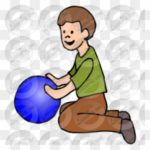
Aim
This activity will give children the opportunity to practice the skill of throwing overhand. At this developmental age, children should focus on throwing hard at the target. This will enable children to go through the full range of the throwing motion and assist them in “stepping with the opposite foot” when they throw. Stepping with the opposite foot when throwing is an important part of demonstrating a mature throwing pattern.
Equipment Required
A yarn ball, Koosh, or beanbag is most appropriate for this activity inside, a plastic ball, or a tennis ball outside. Make sure the ball or beanbag is the size that will easily fit into the child’s hand. Beanbags or yarn balls are best if inside a building as they will not roll away from the children. A small plastic ball can be used outside in a grassy area where there is less chance for the ball to roll away from the child.
Description
Conduct this activity in a large indoor open space such as a gym or multipurpose room where there is a large wall (free of obstacles) to throw at or a large open outdoor space. Ask children to pick up a beanbag and place it in the hand they are going to use to throw (this should be the same hand they write with). “Bend your elbow up and hold the beanbag behind your head, step forward with the opposite foot, and throw the beanbag as hard as you can.” If inside children should be directed to throw hard at the wall. If outside, ask that they throw as far (or hard) as they can into the open field. Teachers may want to place cones or markers in the field so that children have a large target to throw toward. Remember to stress the cues “throw hard” and “step with the opposite foot.” The throwing skills of young children will vary greatly. Some children may want to get close to the wall while others will need the challenge of being farther away. While this activity seems very simple it is an important foundational first step activity for young children learning how to throw.
Note: If children are having trouble stepping forward when they throw, place a tape line, jump rope, or chalk line on the ground and ask that children step over the line when they throw. This will help them begin to develop the opposite foot stepping pattern.
Variations:
As children get the basic concept of throwing hard while stepping with the opposite foot use targets to challenge them to keep practicing. Use large targets indoors such as painting a target on a large sheet and then attaching it to the wall. Outdoors, Provide a restraining line for children to stand behind and ask that they throw over another line that is 20 to 30 feet away. Provide a line that is closer to those that cannot throw as far.
Teaching Suggestions:
With young children, it is important to participate in throwing activities that are both fun and success-oriented. Research tells us that children need to be successful about 80% of the time to stay on task, avoid frustration, and have the best opportunity to develop skills. Children, who consistently miss the target when they throw, may get frustrated and not practice. Throwing activities must be success-oriented in order that children will have the opportunity to develop the skill. The best beginning throwing activity is to simply ask children to throw hard. This allows children to naturally step with their opposite foot when throwing and assists in the development of a mature throwing pattern.
Adaptations for Students with Disabilities:
Many children with special needs may not be able to step when throwing. Ask these children to throw as hard as they can and make sure they have the opportunity to stand as close to the wall or target as needed.







